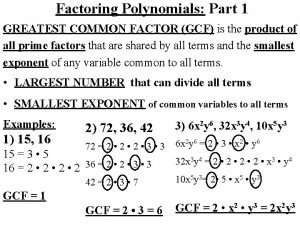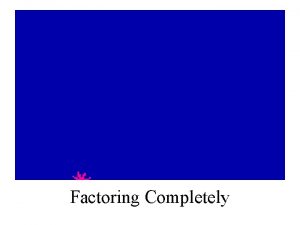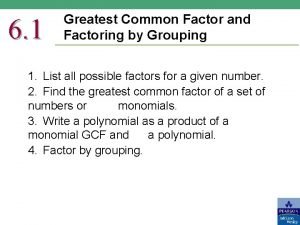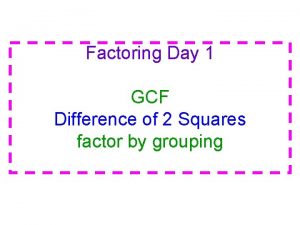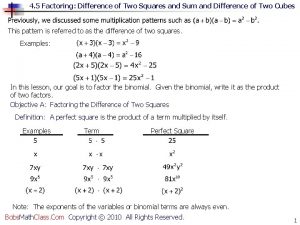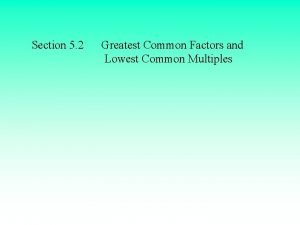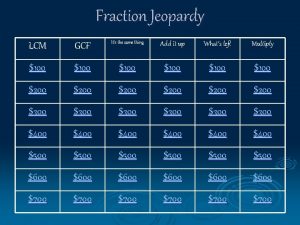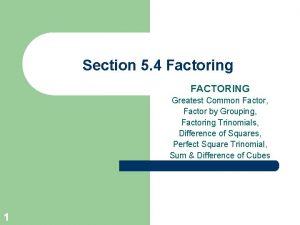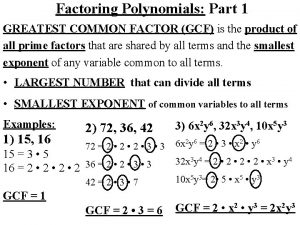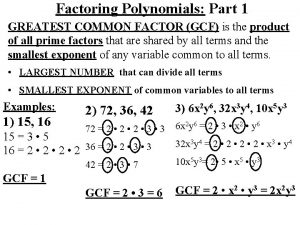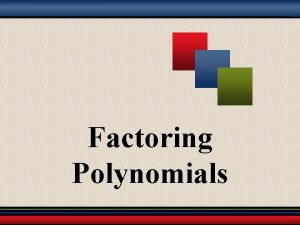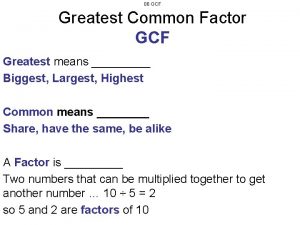Factoring Review Greatest Common Factor Difference of Squares





























- Slides: 29

Factoring Review Greatest Common Factor, Difference of Squares, Box Method, Quadratic Formula

Method 1: Greatest Common Factor n n n Abbreviated GCF When to use it: When each term in the equation share a common factor (may be a number, or a variable) May also be a combo of the two

Steps in GCF n n n Find the common factor(s) in the equation Divide the entire equation by the GCF Pull it outside the equation by separating with parentheses Set equal to zero Locates the x intercepts (roots) of the equation

Y=-x 2+6 x

Y= 2 x 2+18 x+28

Things to Watch out for with GCF n You may be able to use another method to finish factoring at times

Method 2: Difference of Squares n n n When to use it: Two term equation If your terms are both perfect squares Separated by a – sign in the equation

Steps in Solving Using Difference of Squares n n n Check that each term is a perfect square Check that they are separated by a minus sign Take the square root of each equation Place each root in a set of parentheses, with a subtraction sign in one set, and an addition sign in the other Set each parentheses=0 and solve for x

Find the roots of Y=4 x 2 -81

Find the x intercepts of y=x 2 -25

Solve for x: y=9 x 2+36

Things to watch out for with Difference of Squares

Method 3: Box Method n When to use it: When you have three terms to factor

Steps in Box Method

Find the zeros of y=X 2+2 x-3

Find the roots of y=x 2 -8 x+12

Find the roots of y= 8 x 2 -40 x+50

Find the x intercepts of y= 2 x 2 -5 x+2

Find the roots of y=-16 t 2+63 t+4

Things to watch out for with box method n n Need three terms Make sure they are in quad form Watch your negative signs Make sure you are only factoring the leading coefficient and constant terms.

Quadratic Formula n n You can always use the quadratic formula Sometimes there are just easier ways to solve

The Quadratic Formula

What do the variables mean? n n n They represent the coefficients from the quadratic expression Ax 2+Bx+C=0 Keep in mind you only write out the coefficients, not the x 2 or x

Example n Use the quadratic formula to find the roots of x 2 + 5 x-14=0

n Solve x 2 -7 x+6=0

n Solve 4 x 2=8 -3 x

n Solve 2 x 2 -6 x=-3

Graphing Quadratics n n n Using the standard form Ax 2+Bx+C=0 of a quadratic, you can create a graph by looking at several things A tells you if the parabola opens up or down A>1, opens up, A<1, opens down C is the y intercept Factor and solve to find the x intercepts, graph!

Factor, Solve and Graph n n n X 2+6 x=0 X 2 -3 x-1=0 X 2 -5 x-6=0 4 X 2=-8 x-3 5 x 2 -2 x-3=0 -x 2 -3 x+1=0
 Highest common factor of 48 and 60
Highest common factor of 48 and 60 Lesson 1 factoring using the greatest common factor
Lesson 1 factoring using the greatest common factor Factoring greatest common factor
Factoring greatest common factor Cube root formula factoring
Cube root formula factoring Factoring expressions
Factoring expressions Factor by greatest common factor
Factor by greatest common factor Factor out the greatest common factor
Factor out the greatest common factor Lesson 8-2 factoring by gcf
Lesson 8-2 factoring by gcf Find the lcm of 16 24 36 and 54
Find the lcm of 16 24 36 and 54 Difference of squares trinomial
Difference of squares trinomial Difference of 2 squares
Difference of 2 squares Difference of two squares examples
Difference of two squares examples How do you find the greatest common factor of two numbers
How do you find the greatest common factor of two numbers Gcf 84 and 56
Gcf 84 and 56 Hcf of 30 and 40
Hcf of 30 and 40 The gcf of two whole numbers is the
The gcf of two whole numbers is the Prime factorization of 84
Prime factorization of 84 What is the greatest common factor of 42 and 84
What is the greatest common factor of 42 and 84 Gcf of 32 and 24
Gcf of 32 and 24 Greatest common factor of 48 and 64
Greatest common factor of 48 and 64 What is the gcf of 18 and 48
What is the gcf of 18 and 48 Greatest common factor of 7 and 9
Greatest common factor of 7 and 9 Gcf of 27
Gcf of 27 Gcf of 42 and 84
Gcf of 42 and 84 Find the gcf of each pair of monomials
Find the gcf of each pair of monomials Factors of 36 and 24
Factors of 36 and 24 Gcf of 42 and 84
Gcf of 42 and 84 Common factors of 8 and 36
Common factors of 8 and 36 Greatest common factor of 48 and 36
Greatest common factor of 48 and 36 Factor out completely
Factor out completely


